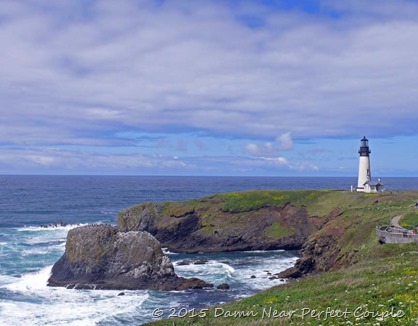 We’ve been at our summer volunteer position at the Bureau of Land Management's Yaquina Head Outstanding Natural Area for a little over a month and have settled into our jobs as Tide Pool Guide (me) and Interpretive Center Host (Brenda). This is an unusual experience for us; volunteering at a large, visitor-intensive location (over 350,000 a year), with a fairly large staff of professionals dedicated to providing an interesting and educational environment. Visitors come to tour the historic lighthouse, (Oregon’s tallest and second-oldest), the tide pools, to view the offshore rocks with their Harbor Seals and seabird colonies, and the amazing Interpretive Center.
We’ve been at our summer volunteer position at the Bureau of Land Management's Yaquina Head Outstanding Natural Area for a little over a month and have settled into our jobs as Tide Pool Guide (me) and Interpretive Center Host (Brenda). This is an unusual experience for us; volunteering at a large, visitor-intensive location (over 350,000 a year), with a fairly large staff of professionals dedicated to providing an interesting and educational environment. Visitors come to tour the historic lighthouse, (Oregon’s tallest and second-oldest), the tide pools, to view the offshore rocks with their Harbor Seals and seabird colonies, and the amazing Interpretive Center. Our free RV site is located across from the entrance booth on a high bluff
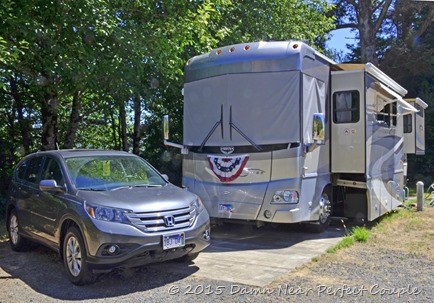 overlooking the ocean. There are three sites, all with full hookups, concrete pads, and access to commercial phone lines and DirecTV and Dish satellite dishes. Our site is shaded with forest on one side, without much of a view, but is quiet and secure.
overlooking the ocean. There are three sites, all with full hookups, concrete pads, and access to commercial phone lines and DirecTV and Dish satellite dishes. Our site is shaded with forest on one side, without much of a view, but is quiet and secure.The Interpretive Center, Brenda’s domain, has two theaters, exhibits of area wildlife and marine animals, displays depicting how the lighthouse was built and operated, and interactive displays for children. Brenda also signs up people for the free tours of the lighthouse. The tours are limited to 16 people at a time since they’re conducted by members of the staff dressed in period costume. During her four-hour shift, she’s assisted as many as 600 visitors.
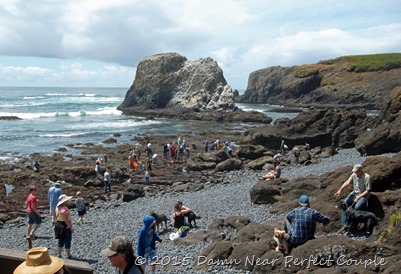 Most of my time is spent on the tide pools, although I also roam around the area answering questions and pointing out the different seabirds, seals, and on occasion, whales. I’ve always been interested in tide pools, but this is my first time as a “guide”, and the
Most of my time is spent on the tide pools, although I also roam around the area answering questions and pointing out the different seabirds, seals, and on occasion, whales. I’ve always been interested in tide pools, but this is my first time as a “guide”, and the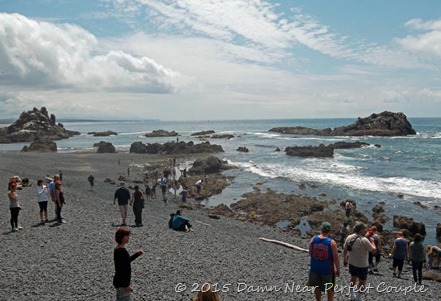 learning process has been steep but enjoyable. During periods of low tide, I and three or four of the seasonal (temporary) employees take turns welcoming visitors to the beach and explaining the rules (what not to take, touch, or step on, etc.), and roaming the beach explaining what people are seeing. So come with me on a tide pool walk:
learning process has been steep but enjoyable. During periods of low tide, I and three or four of the seasonal (temporary) employees take turns welcoming visitors to the beach and explaining the rules (what not to take, touch, or step on, etc.), and roaming the beach explaining what people are seeing. So come with me on a tide pool walk: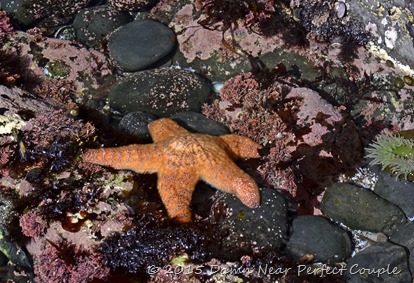 Everyone wants to see a “Starfish”, and we try to explain that the correct name is “Sea Star” since they’re not a fish. The Pacific coast is experiencing a huge die-off of Sea Stars due to a virus that causes them to waste away, and over 95% of the Sea Stars have vanished. We usually have 3-6 on the entire beach, and try to find them early so that people can see them. I enjoy telling the kids how Sea Stars eat mussels – they envelope the mussel and wait for it to open it’s shell to filter for algae, then eject their stomach into the mussel, liquefy and digest the mussel, then pull their stomach back into their body. The usual response from the little boys is “whoa – cool!”, from the little girls, not so much. One little girl, immaculately dressed and very prim and proper, put her hands on her hips and said “that’s disgusting!”. Well, yeah….but that’s what makes it so cool!
Everyone wants to see a “Starfish”, and we try to explain that the correct name is “Sea Star” since they’re not a fish. The Pacific coast is experiencing a huge die-off of Sea Stars due to a virus that causes them to waste away, and over 95% of the Sea Stars have vanished. We usually have 3-6 on the entire beach, and try to find them early so that people can see them. I enjoy telling the kids how Sea Stars eat mussels – they envelope the mussel and wait for it to open it’s shell to filter for algae, then eject their stomach into the mussel, liquefy and digest the mussel, then pull their stomach back into their body. The usual response from the little boys is “whoa – cool!”, from the little girls, not so much. One little girl, immaculately dressed and very prim and proper, put her hands on her hips and said “that’s disgusting!”. Well, yeah….but that’s what makes it so cool!  The Green Sea Anemone is a big favorite, largely because we encourage people to touch it. Gently stroking it’s tentacles causes the Anemone to think prey has arrived, and it will try to grasp the finger. A sticky substance is released to paralyze the prey, although the amount is too small to have any effect on humans. When out of water, they close up into what looks like a brown donut, waiting for the tide to come in. They’ll eat almost anything that comes their way, and if it’s a large object, they extend outward to envelop it, looking like a softball.
The Green Sea Anemone is a big favorite, largely because we encourage people to touch it. Gently stroking it’s tentacles causes the Anemone to think prey has arrived, and it will try to grasp the finger. A sticky substance is released to paralyze the prey, although the amount is too small to have any effect on humans. When out of water, they close up into what looks like a brown donut, waiting for the tide to come in. They’ll eat almost anything that comes their way, and if it’s a large object, they extend outward to envelop it, looking like a softball.Purple Sea
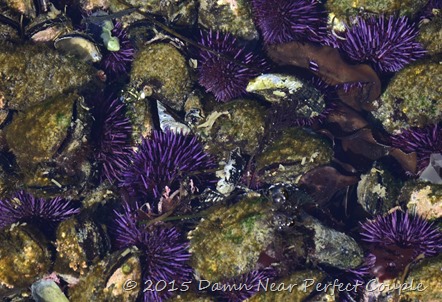 Urchins are common in our tide pools. Their bright purple color is beautiful, and they can live to be 70 years old. A popular source of a sushi dish called “Uni”, Urchins are raised for the Asian market, so I guess ours are “free range” Urchins.
Urchins are common in our tide pools. Their bright purple color is beautiful, and they can live to be 70 years old. A popular source of a sushi dish called “Uni”, Urchins are raised for the Asian market, so I guess ours are “free range” Urchins. 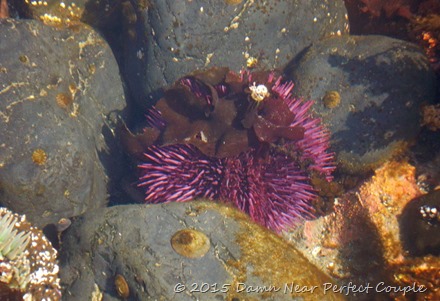 They have pinchers located inside their spines and use them for both defense from Sea Stars and to cover themselves with any handy object to block UV rays. For those who might enjoy “Uni”, you might want to know that what is marketed as Purple Urchin Roe is actually the urchin’s gonads. Then again, you might not want to know….
They have pinchers located inside their spines and use them for both defense from Sea Stars and to cover themselves with any handy object to block UV rays. For those who might enjoy “Uni”, you might want to know that what is marketed as Purple Urchin Roe is actually the urchin’s gonads. Then again, you might not want to know…. One of my favorites is a large mollusk called the Gumboot Chiton. They can grow to a foot long, eat algae that they scrape off of the rocks with their tongue, and move slowly through the pools, earning them the name “The Wandering Meatloaf”.
One of my favorites is a large mollusk called the Gumboot Chiton. They can grow to a foot long, eat algae that they scrape off of the rocks with their tongue, and move slowly through the pools, earning them the name “The Wandering Meatloaf”. 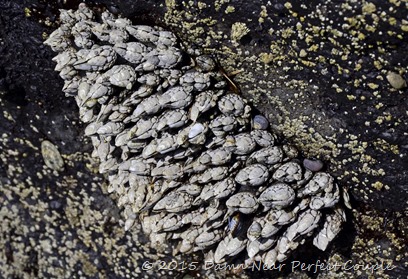 The rocks are covered with California Mussels and Gooseneck Barnacles, both of which are edible, although not many people try the barnacle because of it’s appearance. Hermit and Porcelain crabs abound, with Turban snails, Limpets, Periwinkles, and occasionally a cute but foaming-at-the-mouth Purple Shore Crab.
The rocks are covered with California Mussels and Gooseneck Barnacles, both of which are edible, although not many people try the barnacle because of it’s appearance. Hermit and Porcelain crabs abound, with Turban snails, Limpets, Periwinkles, and occasionally a cute but foaming-at-the-mouth Purple Shore Crab.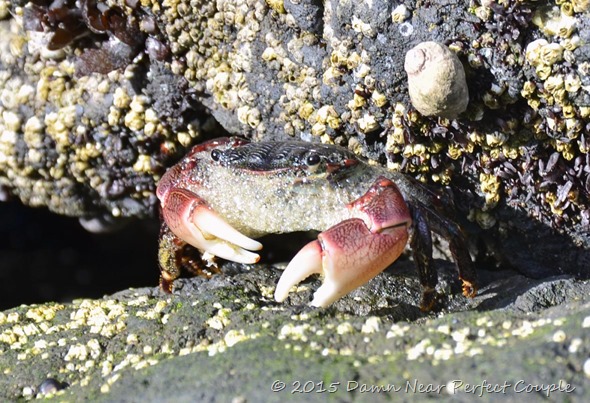
On a sunny day, the pools are full of color:
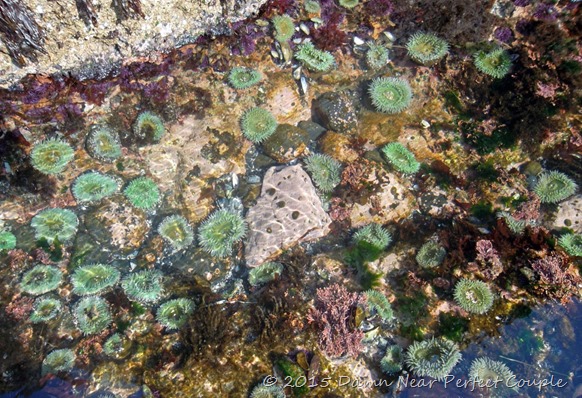
The tide pools are fascinating; full of color, movement, and interesting creatures. And the views from the pools are not bad either, especially looking up at the lighthouse:
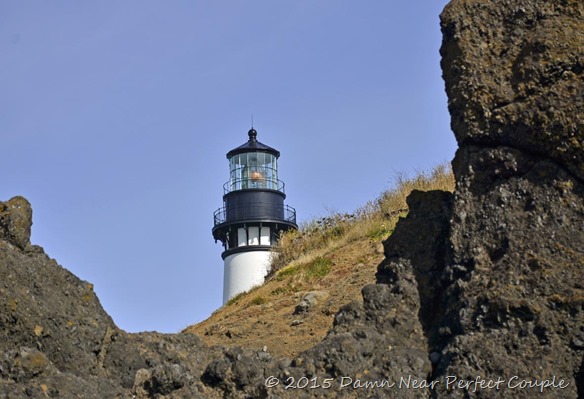
The Yaquina Head Outstanding Natural Area is located a few miles North of Newport, a typical coastal tourist town of overpriced restaurants and expensive galleries, and cheap trinket places. One area we enjoy visiting is the harbor with it’s many boats and huge bridge:

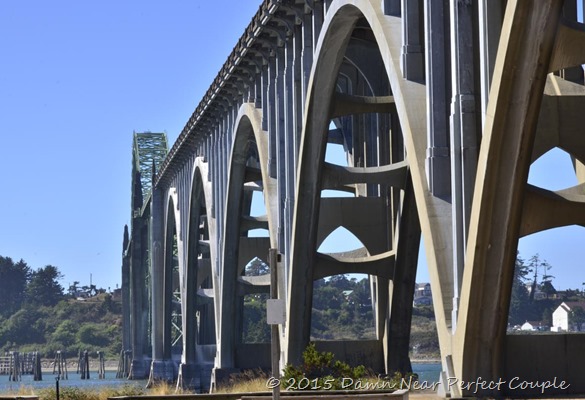
The cliffs surrounding the Interpretive Center are home to a number of Peregrine Falcons. The cliffs are dominated by a young female known as the “Evil Queen” for her habit of screaming and driving off the this year’s fledglings and a lone male. She watches us each day as we walk across the parking lot, daring us to come closer…
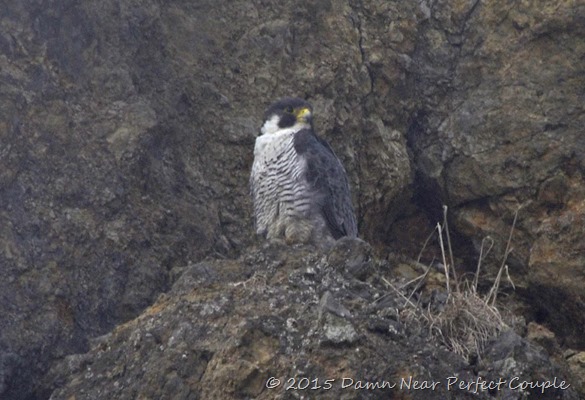
And finally, even though most of the days are dreary and foggy, once in a while the sun will shine and we’ll have his view that makes us happy we came here:

It’s been a great summer here on the coast, and we’ve more to share with you, so stop back and check in!